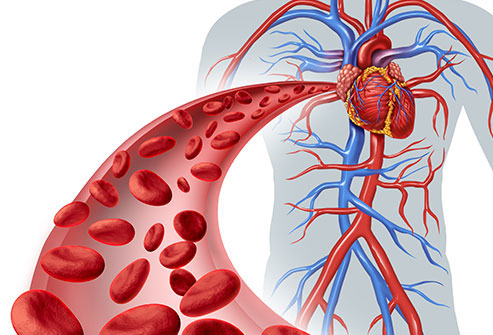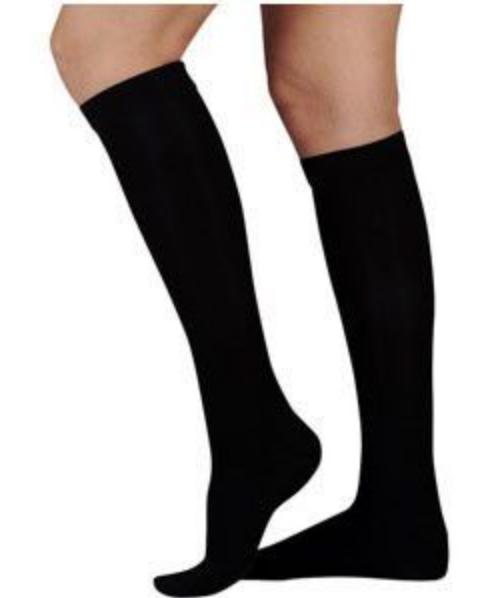Compression socks are used by many people of various occupations, backgrounds, and interests: pilots, nurses, flight attendants, expectant mothers, runners, patients recovering from surgery, desk workers, and more. With growing use of these garments, there is also a growing curiosity from non-users and first-timers on what kind of compression socks would be best for them and what factors need to be considered before buying a pair. This guide aims to help you be more informed before purchasing compression socks.
The Importance of Proper Blood Circulation

Your body contains 60,000 miles of blood vessels and it is these vessels that play a critical role in delivering oxygen and nutrients throughout the body as well as transporting waste away from the organs and muscles.
If the blood vessels in your body, such as the legs, are not flowing efficiently, then problems may start to occur. Numbness or coldness may develop, wounds could heal slower, among others. There are certain conditions, such as obesity and diabetes, which could affect one’s blood circulation.
How Compression Socks can Assist in Proper Blood Circulation
One way to improve circulation in the legs and feet is by wearing compression garments, such as compression socks.
Blood that is traveling back to the heart from the legs must flow against gravity. To understand how compression socks can help us, we need to first understand how blood flows from the legs to the heart.
- Blood flows in the deep veins as it travels from the legs to the heart.
- This flow is facilitated by pressure applied by a series of venous valves which forces the blood up and prevents it from flowing backward.
- Pressure on the veins pushes the blood toward the heart.
- Healthy legs have veins with smooth, elastic walls designed to adapt to any changes in pressure within a vein. Unfortunately, if venous valves are damaged by varicose or thrombosis, they can dilate and fail to close properly. This could cause blood to pool in the deep veins and result in swelling.

Compression socks gently squeeze the legs, ankles, and feet, which forces blood into narrower channels, thus increasing lower body arterial pressure and, in turn, make it easier for blood to return to the heart.
This compression feature can benefit many; athletes use them to improve their performance and reduce the chances of injury while people with leg diseases, such as varicose veins or deep vein thrombosis, wear them to ease pain and prevent their conditions from worsening. Pregnant women, people who stand for long periods and people recovering from surgery can also make use of these socks.
Reasons to Wear Compression Socks
Reasons for wearing compression stockings, or socks, vary on one’s health condition.
Below are some cases that may require to compression therapy:
- Pregnancy-related swelling,
- Varicose veins,
- Lymphedema,
- Swelling, blood clots, or pain in the lower legs,
- Deep vein thrombosis,
- Poor circulation due to sitting continuously for hours,
- Post-sclerotherapy and post-surgical treatment.
Compression socks can be used as a preventative measure for conditions stated in the above list in order to maintain healthy legs and feet.
Benefits of Wearing Compression Socks
1. Improves Productivity
Individuals whose work involves standing up or sitting down for long periods can reduce the chance of getting swollen feet or aching calves by wearing compression socks. These socks invigorate the feet and legs by alleviating muscle stiffness caused by the lack of movement, thus allowing more focus on getting work done rather than on uncomfortable legs.
2. Relieves Pregnancy-Related Swelling
Pregnant women can find relief from aching and swollen feet when they use compression socks; they offer a comfortable, cooling effect and are easy to put on.
3. Helps during Recovery
Doctors recommend using compression socks to help during recovery; particularly, after a patient has undergone surgery or is managing chronic illnesses and pain.
4. Maintains Circulation during Travel
Lack of mobility when traveling causes lower blood flow to the legs and feet; sitting or standing for long periods of time increases the risk of blood clotting, blood pooling, aches or swelling. Wearing compression socks can help blood to effectively circulate due to the pressure applied to the ankles and calves.
5. Assists in Athletic Performance
Athletes wearing compression socks, or stockings, during training sessions to improve their performance. Wearing them during and post-workout can also quicken muscle recovery by improving the process removal of lactic acid and reducing muscle wear-and-tear.
Who can Wear Compression Socks
Almost everyone can wear compression socks, be they individuals with medical conditions, have jobs which require sitting for long hours, travel often, are pregnant, or have an active lifestyle.
However, they may not be suitable for those with particular medical conditions as they can uncomfortable for people with open wounds on their legs, have severe peripheral arterial disease, damage to the nerves in the feet, have diabetes, or skin infections.
It is recommended to first seek advice from a medical professional to confirm whether compression socks can be worn.
Popular Articles on ComproGear
Plus Size Compression Socks Extra Wide Compression Socks
Compression Socks for Gout Compression Socks Gout
Rose Toy What is a Rose for Women?
How Long To Wear Compression Socks for Edema? Compression Socks Before and After
Compression Sock Sizes Compression Socks Size Chart
Best Compression Socks for Ankle Swelling Best Compression Socks for Ankle Injury
Compression Levels
There are various compression levels, which are measured in ‘millimeters of mercury (mmHg)’, for different needs; higher compression levels, such as 20-30 mmHg or above, is typically used for more severe health conditions, such as deep vein thrombosis, and can only be worn under a doctor’s supervision.
- Mild Compression Socks – These have the lowest compression level of 8–15 mmHg and are generally used to relieve the body from mild aches or muscle fatigue.
- Medium Compression Socks – These have a compression level of 15–20 mmHg which can be worn for regular use.
- High Compression Socks – These have a compression level of 20–30 mmHg, can help manage ulcers and prevent post-surgery blood clotting.
- Extra Firm Compression Socks – These have a compression level of 30–40 mmHg, can help treat severe edema and lymphedema, and are useful for treating chronic venous insufficiency and other severe conditions.
Styles of Compression Socks
Different styles are chosen based on need and attire.
1. Graduated compression socks
Graduated compression socks exert the greatest degree of compression at the ankle and decreases as it goes upward. This allows blood from the lower extremities to flow back to the heart easier. Graduated compression socks can be used to treat edema and most are manufactured with quality material and consistency to ensure that the gradual compression is effective.
2. Anti-embolism compression stockings
Just like graduated compression stockings, the feature compression that is greatest at the ankle and reduces as it goes upward. However, they are designed for bedridden patients and individuals with restricted movement, thus offer more compression pressure than normal gradient compression stockings.
3. Non-medical support hosiery
Unlike graduated compression garments, non-medical support hosiery provide uniform compression. The compression exerted is lesser than the graduated ones, can be purchased with a prescription, and are often used to relieve tired, heavy and aching legs.
There are also different lengths available, such as the following:
1. Knee-High Compression Socks
Just as the name suggests, these reach the height of the knees. They are available in many colors in open and closed-toe styles.
2. Thigh-High Compression Socks
These reach the mid-thighs and are also available in many colors in open and open-toe styles.
Material used in Compression Socks
Finding compression socks that are breathable and are not too thick, but also not too thin, can be challenging. This depends on the material they are made of and how well designed they are; different materials can be combined to bring maximum comfort to the wearer.
In 1959, Spandex was created and patented by DuPont. It was as close to natural rubber in terms of strength and elasticity but also resistant to certain chemicals and heat; thus, dawned a new era for elastic clothing.
Spandex has been used widely in the making of compression socks due to its elasticity. To achieve the best results, spandex and natural rubber are usually combined with different materials to enhance comfort. When spandex and nylon are combined, the material is lightweight and also helps wick away sweat and moisture from your feet.
Other materials that are used in the manufacturing of compression garments include: bamboo rayon, merino wool, polyamide/nylon, and polypropylene. In most cases, the materials are used in combination. The proper combination of materials helps with moisture management, thermo-regulation, and odor control. Merino wool is mainly used in high-end compression products. The material is durable, soft and fast drying.
How to Wear Compression Socks
- Since compression socks are tight, applying lotion to your skin before wearing them can make it easier to put them on. Ensure that the lotion is well absorbed into the skin before doing so.
- Hold the top of the socks, roll them down towards the heel, put a foot inside and slowly unroll the sock up your leg.
- Smooth out any creases and folds.
Compression Socks: Tips and Tricks
- Check with your doctor first – Make sure that you seek medical advice before buying a pair of compression socks as they can be harmful if you choose the wrong compression strength.
- Use talcum powder – If you have trouble putting on or removing compression garments, try using powder on your skin to help it glide on your skin.
- Do not wear compression socks overnight – The most appropriate time to wear these socks is early in the morning before any activity.
- Adjust throughout the day – Compression garments will not work properly if you are not wearing them correctly. So if you start feeling uncomfortable, simply readjust them.
- Read customer reviews and do research before purchasing – It is important to note that while peer reviews are a wonderful way to rate a product, they do not always reflect the expectations of the buyer. That is why you’ll need a deeper understanding of the product you are seeking to buy especially when the product is of medical use.
- Read the product description – Individuals who may be allergic to latex but do not check the material used in compression stockings are at risk of accidentally purchasing one containing latex in the material composition and suffering from an allergic reaction once wearing them, so it is very important to read the product description and material composition beforehand.
- Replace them after 6 months and own at least 2 pairs – If compression socks are worn daily, owning at least 2 pairs would be ideal so that when one has just been washed, another pair can be worn. It is also recommended to replace compression socks every six months.
Conclusion
- Compression socks are useful for trying to prevent certain medical conditions stated in this article, help increase blood flow from your feet to your heart, and preventing pooling of blood in the lower extremities.
- Seek medical advice before purchasing compression socks, however socks with low compression levels can be purchased over-the-counter. Higher compression strengths will need a prescription from a doctor as they can be more harmful if you put on a wrong compression level.
- There are many styles and levels to choose from.
- Doing simple things, such as reading the product description before purchasing, can help you find the right pair of compression socks.
